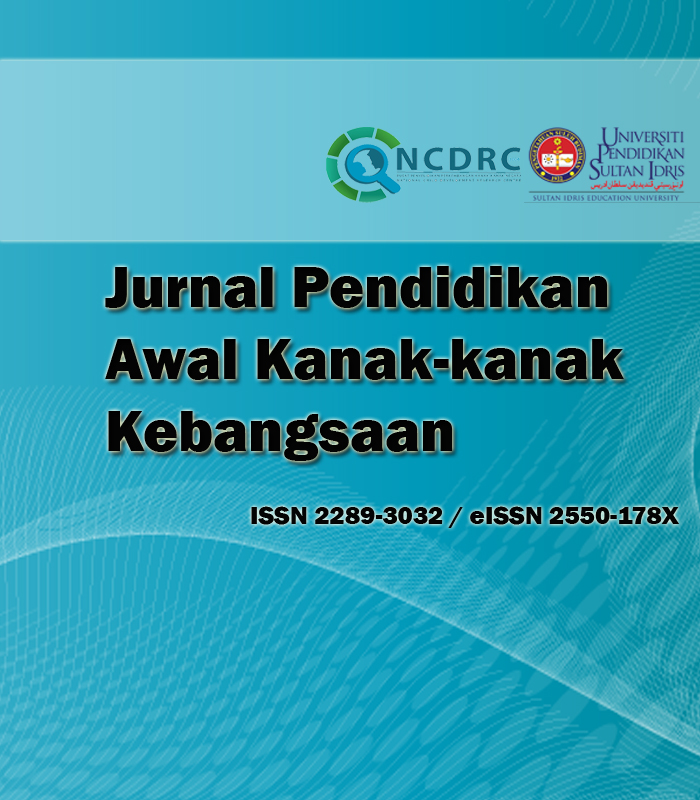Role-play in teaching English as second language in early childhood education
DOI:
https://doi.org/10.37134/jpak.vol9.sp.13.2020Keywords:
role-play, English as second language, early childhood educationAbstract
The major concern of this study is to expose role-play activities in developing children’s English language skills. This paper will explore the level of knowledge of role-play activities among teachers before detailed descriptions about the role-play activities to be further discussed in developing and enhancing the children English language skills as well as the challenges faced by teachers when conducting the activities. This research uses a qualitative method. The researcher has conducted a semi-structured interview with three preschool teachers from Bachok district schools. A set of 16 questions based on the research question is used as the research instrument. The data from the interview is analysed using thematic analysis where themes were picked from the interview with the respondents. First, this study is aimed to help teachers to plan and conduct role-play activities in preschools and kindergarten. The findings show that the teachers are well-versed with the role-play method and also have been practising the method for some time now. The findings also indicate that the role-play method indeed has an influence in helping the children learn English as Second Language. This research also helps teachers to understand better and reflect about their role-play sessions that they have done before and figure out the problems and ways to overcome them and improvise for better outcomes. Hence, this study helps reader to understand that role-play activities are related to children’s development especially in social, emotional, physical and cognitive of the children and the best technique to guide the children learn English as their Second Language.
Downloads
References
Beck, I. L., McKeown, M. G., & Kucan, L. (2013). Bringing words to life: Robust vocabulary instruction (2nd ed.). Guilford.
Best, S. (2016). Understanding & doing successful research. Routledge.
Budden, J. (2004). “Role play”. British Council. Retrieved from: http://www.teachenglish.org. uk/think/articles/role-play.
Carr, M. (2001). Assessment in early childhood settings: Learning stories. Sage.
Chua Yan Piaw. (2014). Kaedah penyelidikan. McGraw Hill Education.
Craciun, D. (2010). Role–playing as a creative method in science education. Journal of Science and Arts, 10(1), 175-182.
Dulay, H., & Burt, M. (1974). Natural sequences in child second language acquisition. Language Learning, 24, 37-53.
Ismail, H., Abdul, M. A., & Mohamad, I. (2019). The effect of Islamic visual art education on social development of preschool children. Jurnal Pendidikan Awal Kanak-kanak Kebangsaan, 8, 1-7.
Livingstone, C. (2004). Role-play in language learning. Longman.
Mamat, N., & Asong, R. (2014). Penggunaan cd multimedia interaktif dalam meningkatkan kefahaman bahasa Inggeris dan mengubah tingkah laku pembelajaran kanak-kanak prasekolah. Jurnal Pendidikan Awal Kanak-kanak Kebangsaan, 3, 79-99. https://ejournal.upsi.edu.my/index.php/JPAK/article/view/791.
Masnan, A. H., & Mohd Radzi, N. M. (2015). Pengetahuan persediaan pengajaran guru prasekolah baru. Jurnal Pendidikan Awal Kanak-kanak Kebangsaan, 4, 90-108. https://ejournal.upsi.edu.my/index.php/JPAK/article/view/848.
Mohamad Albaree Abdul, Hazhari Ismail, Iylia Mohamad, & Zaharah Osman. (2019). Perkembangan emosi kanak-kanak menggunakan kaedah pengajaran berasaskan aktiviti muzik. Jurnal Pendidikan Awal Kanak-Kanak Kebangsaan, 8, 17-23. https://ejournal.upsi.edu.my/index.php/JPAK/article/view/2881.
Mohd Yusop, N. A., Abdul Rahman, N., Md Yassin, S., & Mohamed Isa, Z. (2018). Penyiasatan secara inisiatif kanak-kanak menerusi pendekatan projek. Jurnal Pendidikan Awal Kanak-kanak Kebangsaan, 7, 30-49. https://ejournal.upsi.edu.my/index.php/JPAK/article/view/910.
Othman Lebar. (2015). Penyelidikan kualitatif: Pengenalan kepada teori dan metode. Penerbit UPSI.
Scott, L. A. (2017). 21st century skills early learning framework. USA: 21st Century Learning for Childhood. http://static.battelleforkids.org/documents/p21/P21_ELF_Framework_Final_20pgs.pdf
#:~:text=The%2021st%20Century%20Skills%20Early%20Learning%20Framework%20
%28P21,and%20policymakers%20to%20include%20early%20learning%20as%20they
Shangeetha, Rajah Kumaran, & Saravanan Loganathan. (2010). The use of role play in speaking activities in secondary classrooms. Lambert Academic Publishing.
Trawick-Smith, J., & Dziurgot, T. (2011). ‘Good fit’ teacher-child play interactions and the subsequent autonomous play of preschool children. Early Childhood Research Quarterly, 110–123.
Walsh, D., Tobin, J., & Graue, M. (1993). The interpretive voice: Qualitative research in early childhood education. In B. Spodek (Ed.), Handbook of research on the education of young children, 464-474. Macmillan.
Williams-Siegfredsen, J. (2017). Understanding the Danish forest school approach: Early years’ education in practice. Taylor & Francis.
Xu, Y., & Drame, E. (2008). Culturally appropriate context: Unlicking the potential of response to intervention for english language learners. Early Childhood Education Journal, 35, 305-311.
Downloads
Published
Issue
Section
License
Copyright (c) 2020 UPSI Press

This work is licensed under a Creative Commons Attribution-NonCommercial-ShareAlike 4.0 International License.





